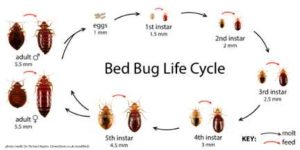
Bed bugs are small biting insects that can multiply quickly and travel easily. It is possible for anyone to have an infestation of bed bugs regardless of income or type of dwelling. People dealing with an extreme active infestation can experience stress and anxiety, lose sleep and spend a lot of money. As with all insect bites, secondary skin infections and allergic reactions are also of concern.
Preventing bed bugs from entering your home is the most important step in preventing an infestation.
To reduce the chances of an infestation, follow these steps:
- Reduce places where bed bugs can hide.
- Get rid of clutter.
- Vacuum often, including under and behind beds.
- Repair or remove peeling wallpaper and tighten loose electrical faceplates.
- Seal all cracks and crevices on wooden bed frames, between baseboards, and in walls, ceilings, windows, door frames, and furniture.
- Check any entry points on walls that you share with neighbours, and openings that allow access to the inside of the wall (like areas where pipes, wires and other utility services enter).
- Be careful about what you bring into your house or buy.
- Check every item you bring into your home for the first time, including used books, new furniture, and garage sale or antique store furniture.
- Be very cautious with second-hand or refurbished items.
New mattresses are often delivered in the same truck that carries away old mattresses. So be careful to check your new mattress before it enters your home. Insist that your new mattress be sealed before it is delivered.
Never take a mattress or sofa from a curb.
Check items before you put them in your vehicle and check your vehicle after helping a friend move.
Regular inspection is important to prevent infestations. To thoroughly inspect your home, you will need a few simple tools:
- Flashlight
- Something to scrape along mattress seams and other crevices (like an old credit card cut into a long triangle: use it in a sweeping motion in narrow spaces to chase bed bugs out of hiding)
- Screwdrivers for removing electrical faceplates and taking furniture apart (always be sure the power is turned off before opening an electrical outlet)
- Alcohol, glass-cleaner, or baby wipes for checking if stains are bed bug droppings (if spots dissolve into a reddish brown colour when rubbed, the spots could be bed bug droppings)
- Cotton swabs for checking stains in crevices
- White plastic bags that can be sealed, for your belongings
Check on, under and beside beds, couches and upholstered furniture. Look for black/brown spots (dried blood or feces), white spots (eggs – very hard to see), or live or dead bed bugs.
If you find signs of bed bugs, you should carefully widen the area of your inspection. If you have a pet, check areas where your pet sleeps as well.
Checking a bed for bed bugs
Remove and inspect all bed linens, including pillows. If you see signs of bedbugs, wash the linens using the hot cycle of your machine.
Slowly lift up each corner of the mattress and examine all creases, tufts, and buttons, along each side of any piping material sewn onto the edges, along mattress handles and air holes, and under pillow tops.
Slowly lift up each corner and check where the box spring sits on the bed frame.
Look closely at the top surface of the box spring, inside folds of material, along seams, and where the fabric is stapled to the box spring. Also check along the edge of the cloth underside. If you see signs of bedbugs, flip the box spring upside-down and remove the cloth underside to look inside the box spring.
Check all surfaces, crevices, screws, staples, tacks, and under wooden plugs that cover screw or nail holes on the bed frame, legs, and headboard.
Also, go over the wall behind the bed (bed bugs can hide in wallpaper and electrical outlets). Remove electrical, telephone, or cable faceplates to check behind them. Always be sure the power is turned off before opening an electrical outlet. Pay extra attention to gaps in the baseboard or rips or bumps in wallpaper.
You should throw your bed out if you find bed bugs inside the box spring or where holes or worn spots in the fabric of the mattress are. These spots can allow bed bugs to lay eggs in places that are not easy to reach for treatment.
If you do throw out your bed or any other infested items, wrap them in plastic and tape off the edges to prevent spreading bedbugs on your way to the trash. Put a sign on the item saying it has a bedbug infestation, so that no one else takes the problem home with them.
Checking furniture for bedbugs
Remove any loose cushions and check the creases, especially the seams and around the zippers of upholstered chairs and couches. Check the seating area and any creases along the sides and back of the chair or couch. Check the legs, especially where they join the upholstery, and where the fabric is tacked to the frame.
Go over all corners and surfaces of wood furniture like dressers, cabinets, tables, chairs, and bookshelves. Remove drawers and look at the inside, the top, sides, back, and legs, paying extra attention to any cracks. Use the crevice tool to check any gaps (like between a shelf and bookcase frame, and under metal drawer slides).
Wicker furniture is an ideal hiding spot for bed bugs. So check it carefully.
( The information provided in this week’s column is from Canadian government sources.)


